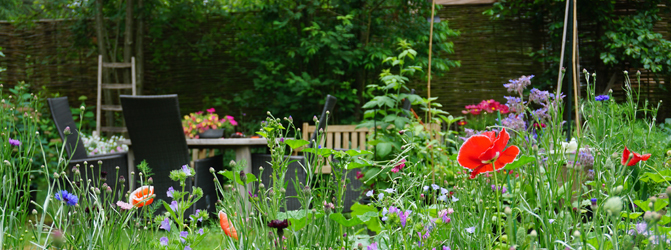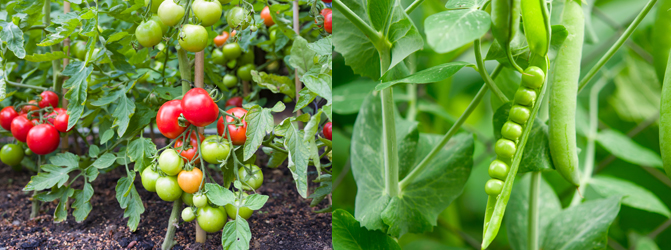
Planting for the planet – creating a Net Zero garden
Almost a third of the urban surface area in the UK is covered by residential gardens, according to Ordnance Survey. This presents gardeners with a unique opportunity to help mitigate climate change.
Research by the Royal Horticultural Society suggests that if every one of the UK’s 30 million gardeners planted one medium-sized tree and let it grow to maturity, they’d store the same amount of carbon produced by driving 11 million times around the planet. And if every gardener produced 190kg of compost each year, they’d save the amount of carbon used by heating half a million homes for a year.
But even if you can’t commit to action on that scale, by instigating a few simple changes around your garden you can turn it into a trap for holding carbon, and a source of freedom for wildlife and biodiversity.

Don’t be neat and tidy
Using your lawn mower less is one of the most important ways you can reduce your energy consumption in the garden. Operating a petrol lawn mower for an hour releases as much smog-forming pollution as driving for 100 miles, according to the California Air Resources Board. If your mower is an electric or battery-powered machine, leaving it in the shed will help you use less electricity. Plus, if grass is allowed to grow longer, it holds moisture for longer – great for those ever-more extended spells of dry weather, and if lawns are left alone, environmentalists believe they can become thriving wildlife hotspots.
Let the white clover take over (well, just a little). White clover has nitrogen-fixing roots that help feed the lawn. Plus, pollinating insects like the white flowers. Dare we say it, you could even allow a few weeds to grow wild, maybe in a hidden corner. Wildlife loves weeds and encouraging it into the garden creates natural eco systems – attracting natural pest controllers to your garden also means less need for chemical-based pesticides.

Grow your own
Growing your own fruit and vegetables has an obvious advantage – as well as being fresh and delicious, they’ve not been delivered in a carbon-emitting, diesel-swallowing van or lorry to a supermarket. Beware though, don’t cancel out the good deed by using peat-based growbags (digging peat releases masses of carbon) or artificial fertilisers to grow them. Rotating your crops can also help – for example, peas and beans fix nitrogen in the soil that will benefit the following year’s courgettes. Plant fruit trees – as well as providing healthy food for humans and animals, they lock in carbon. Research from Cornell University reveals that apple trees can absorb between 10-20 tonnes of carbon dioxide per acre each year, and release 15 tonnes of oxygen.
Do not disturb
As well as mowing and weeding less, you could also cut back on your spade action in the garden. Constant digging and disturbing of the soil releases carbon into the atmosphere. But planting shrubs and perennials with deep roots mean they come back year after year, reducing the need for digging. (They also need less water, too.)
Make your own
You can also make your own compost. Recycle every last fallen leaf, grass clipping and potato peeling and turn it into homemade compost and living mulch. Creating your own compost and adding it to plants improves the soil’s ability to stabilise carbon and because it increases plant growth it absorbs more carbon dioxide from the atmosphere.
Forget fences - hedge your bets
Yes, a hedge takes longer to grow then putting up a fence, but it will never need painting, and hedges capture carbon. Yew, hawthorn and holly can take pollutants from the air, improving air quality. Plus hedges are perfect homes for wildlife. A spikey hedge is also a better deterrent to intruders, who may think twice about attempting to hurdle over hawthorn.
Insulate your house – with plants
Climbing plants that cover exterior walls will insulate the building. They also stop walls heating up and releasing the heat in the night, reducing UHI (urban heat island effect). A study by the RHS and Reading University found that ivy is the most effective plant cover for cooling buildings – reducing the internal and external wall temperature by 7.20C and 5.70C respectively.
Cut out the cut flowers
Why buy daffodils and sweet peas from a shop? As mentioned earlier, transporting goods to shops produces emissions from delivery vans. It’s far more rewarding (and cheaper) to fill your house with flowers you’ve grown yourself.
Another key way that UK gardeners can help mitigate change is in the way we manage rainwater. As climate change leaves us with prolonged periods without rain, it’s no exaggeration to suggest that slowing down rainwater’s return into the ground – or holding onto it for later use – is more important now than it’s ever been. It’s vital to slow down rainwater runoff to prevent it from overwhelming public sewers and being released into rivers as dirty water.
DON’T pave over the garden
The natural cycle of rainwater is disturbed by hard surfaces, such as concrete, whereas grass and plants take pressure off public drains by taking water up from the soil, and returning it as evapotranspiration. By keeping as much green space as possible in your garden you can help the water to infiltrate the soil slowly and return to rivers and seas as groundwater.
Keep it permeable. Go gravel or reinforced grass
Where you do need to introduce hard surfaces into your garden, for driveways, paths etc. why not make them porous instead? Using gravel or reinforced grass on paths and driveways allows rainfall to infiltrate back into the ground, where concrete doesn’t. Ground reinforcement tiles, like ACO GroundGuard, made from 100% materials, stabilise grass or gravels paths and driveways, and are 90% porous, providing effective drainage of the surface water. They also stop the spread of weeds, reducing the need to use environmentally unfriendly weed killers and chemicals.
Rains over Mains
As well as slowing down the return of rainwater to the ground we can also hold on to it for using later. Abandon the sprinkler, turn away from tap water and have faith in the humble water butt. Place one everywhere you can that could capture rainwater. Rainwater also contains less chalk, so it’s much better for plants and flowers.
The RHS are encouraging households across the UK to do this by signing up to their Mains2rains pledge, to switch from using tap water to rainwater for watering their gardens. Their suggestions for alternatives include placing drip-trays beneath plant pots to collect drainage, adding mulch around new plants, and using self-watering pots or planters that capture rainwater.
If you want to save rainwater on a larger scale, products such as ACO Rain4me can help you to gather this resource in greater quantities. Up to 50% of drinking water can be saved by using rainwater, and rainwater harvesting also protects your pipes and household appliances, as it is particularly low in chalk.
Another very effective way to retain rainwater is to create a rain garden, a shallow area of ground or garden designed to capture runoff water from roofs or paved surfaces. You can find out more about this here, www.aco.co.uk/news/article/creating-a-rain-garden.
To cope with the challenges associated with climate change, our gardens will need to become more resilient to sometimes-hotter, sometimes-wetter conditions. But by addressing these issues using the tips and techniques outlined above, our gardens could actually help keep climate change from running out of control.
We’d really like to hear your ideas for containing carbon and encouraging biodiversity in your garden – get in touch here technologies@aco.co.uk